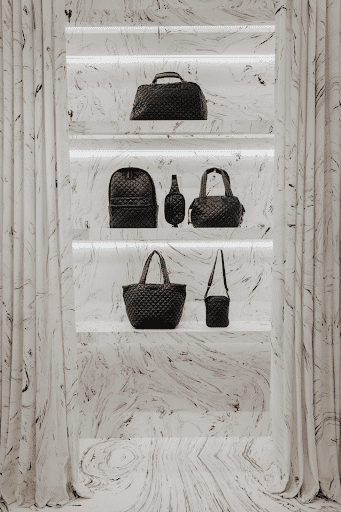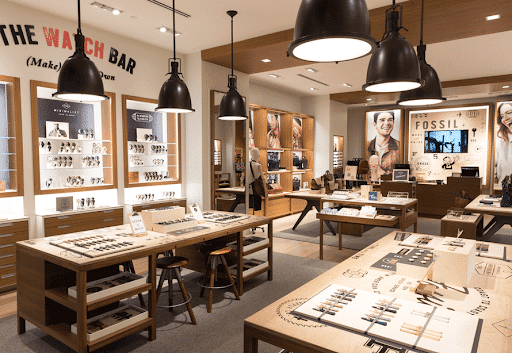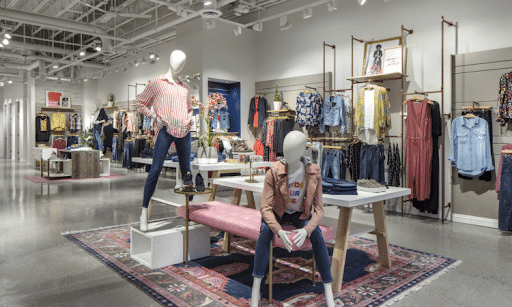LED retail lighting offers numerous benefits over other lighting options. LED has become the only realistic lighting option due to its energy efficiency and durability. It adds significant versatility to your lighting design, and there are installation methods that can make it even more energy efficient.
Factors to Consider When Choosing LED Retail Lighting
Color temperature:
The color temperature of LED lighting determines the warmth or coolness of the light. Choosing the right color temperature is necessary for creating the desired ambiance in a retail space. Warm white (2700K-3000K) is suitable for creating a cozy and inviting atmosphere, while cool white (3500K-5000K) is ideal for highlighting products and creating a bright, fresh, or more industrial ambiance.
CRI (Color Rendering Index):
CRI is a measure of how accurately the colors of objects appear under a particular light source. High CRI LED lighting (90+) is recommended for retail spaces to ensure accurate color representation and to enhance the appearance of products.
Color rendering is particularly important because it can significantly impact the perception of products by customers. If the colors of products appear dull or inaccurate under artificial lighting, it can negatively affect the perceived quality of the products and lead to reduced sales. There are many LED options that offer high CRI to ensure your merchandise looks as appealing as possible.
Wattage and lumens:
The wattage and lumens of LED lighting determine the brightness or lumen output of the light. It is important to strike a balance between the desired brightness and energy efficiency. But this does not tell the entire story when choosing a fixture. Before spending too much time worrying about wattage, figure out how much light is needed by reviewing center beam candle-power (CBCP) as well. Once you determine this, find LED lights that offer lower wattages in that light range for energy-efficient lighting.
Beam angle:
The beam angle of LED lighting determines the spread of light. Narrow beam angles (15-30 degrees) are suitable for highlighting specific products, while wider beam angles (60-120 degrees) are ideal for general lighting. Very narrow angles (≤ 10 degrees) can be used to create focus and spotlight smaller items.
Dimming capabilities:
Dimming capabilities are essential for creating different moods and adjusting the lighting levels for different times of the day. Consider using dimmable LED lighting for versatility and creating a comfortable shopping experience.
Durability and lifespan:
LED lights are known for their durability and long lifespan, lasting up to 50,000 hours or more depending on usage, fixture, and manufacturer. This is significantly longer than traditional lighting options.
Different Types of LED Lighting for Retail Stores
Track lighting:
Track lighting is a versatile lighting option that allows for adjustable directional lighting, making it perfect for highlighting specific products or displays in a retail space. It can also be used for general lighting to create a uniform and cohesive look throughout the store.
Recessed lighting:
Recessed lighting is a modern and discreet lighting choice that can be used for general lighting or to highlight specific products or displays in a retail space. It is a great option for creating a clean and streamlined look in the store.
Pendant lighting:
Pendant lighting is a decorative lighting option that can add visual interest and create a sophisticated ambiance in a retail space. It can be used to highlight specific areas or products and is often used in combination with other lighting options for a layered effect.
Surface-mounted or Lay-in lighting:
Surface-mounted lighting is a simple and effective lighting option that can be used for general lighting in a retail space. It is a great option for larger footprint stores to layer with track, recessed and/or pendant lighting.
Display case lighting:
Display case lighting is a specialized lighting option that is used to highlight specific products or displays. It can be used to create a dramatic effect and draw attention to specific items, making them stand out to customers.
 How to Calculate Retail LED Lighting Needs
How to Calculate Retail LED Lighting Needs
Determine the square footage:
Accurately measure the length and width of the retail space to determine the amount of lighting needed and ensure that the space is consistently well-lit and comfortable for customers and staff.
Identify the different zones within the space:
Identifying the different zones within the retail space, such as the checkout area, product displays, and entrance, helps in determining the appropriate lighting design, which will provide the right amount of illumination for specific tasks and areas within the store.
Calculate the necessary wattage and lumens for each zone:
Calculating the necessary wattage and lumens for each zone is critical in determining the energy requirements, the cost of the lighting system, and the quality of light that is needed to create the desired lighting effects. This calculation is based on the square footage, the height of the ceiling, the color temperature, and the desired brightness.
Tips for Achieving the Best Retail LED Lighting Design
Use layering to create depth and visual interest:
Layer different types of lighting to create a multi-dimensional and visually interesting space. This might include using task lighting for specific areas, ambient lighting for general illumination, and accent lighting for highlighting specific products or displays.
Check out our other blog post on retail lighting for more information on adding layers and texture to your store.
Pay attention to color temperature and CRI for accurate color representation:
Use warm white and high CRI LED lighting to create a warm and inviting space with accurate color representation. This can enhance the appearance of products and create a comfortable shopping experience for customers.
Use lighting to highlight specific products and displays:
Use lighting to draw attention to specific products and displays. This can include using directional lighting to create shadows and contrast or using color-changing lights to create a dramatic effect.
Consider the overall aesthetic and branding of the store:
The lighting should complement the store’s theme and enhance the brand identity. For example, a high-end fashion store may use warm, soft lighting to create a luxurious and elegant ambiance.
Connect with Solais Lighting Group for Your Retail Needs
Choosing the best LED retail lighting for your store requires careful consideration of factors such as color temperature, CRI, wattage and lumens, beam angle, dimming capabilities, durability, lifespan, and cost. Different types of LED lighting, such as track lighting, recessed lighting, pendant lighting, surface-mounted lighting, and display case lighting, can be used to create different lighting effects in your retail space.
Calculating your lighting needs and using layering, attention to color temperature and CRI, highlighting specific products and displays, and considering the overall aesthetic and branding of the store are key tips for achieving the best LED retail lighting design.
With the right LED retail lighting, you can create a comfortable and visually appealing shopping experience for your customers while saving on energy costs and increasing the lifespan of your lighting system. Reach out to us at Solais for a consultation on LED lighting for your store.

